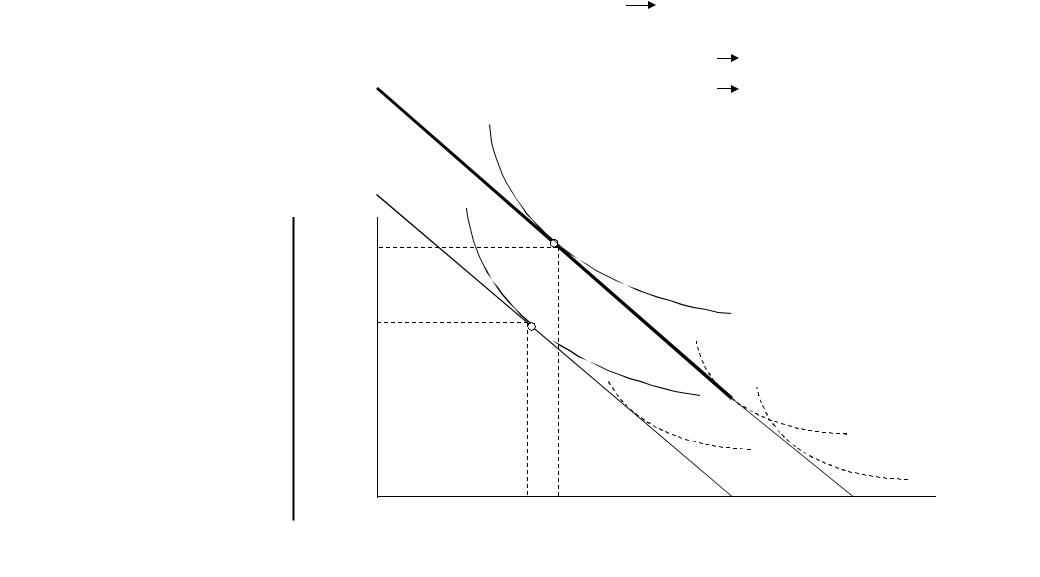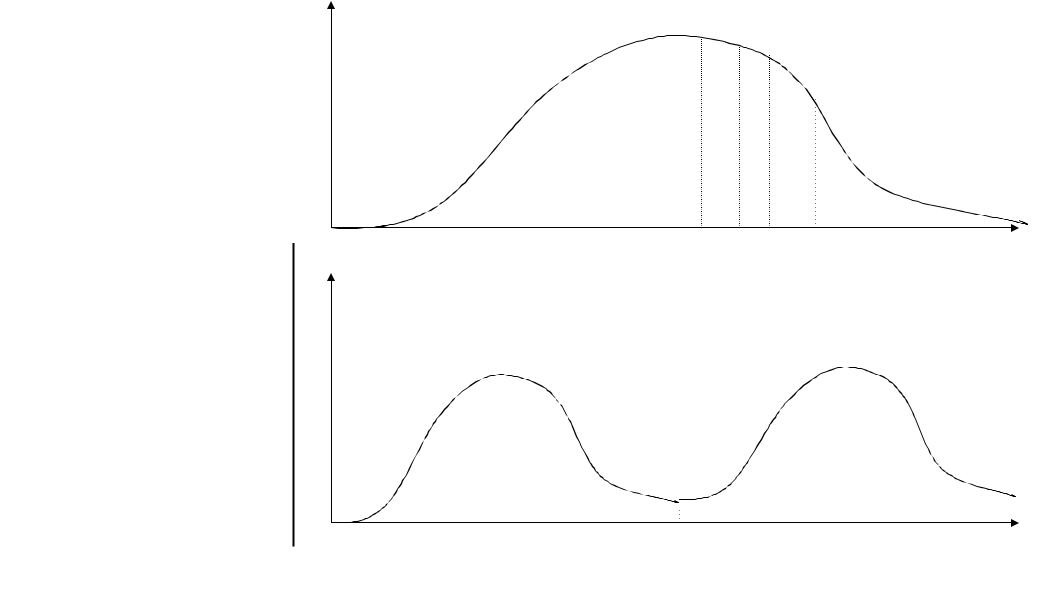
Public Choice In a Representative Democracy
.pdf
Andreas Freytag
1.Introduction
2.Origins of the State
3.Public Choice in a Direct
Democracy
4.Public Choice in a Representative Democracy
5.Application of Political
Economy Models
6.Normative Public
Choice
Public Choice
Intergovernmental grants under federalism
Is there a justification for grants from one governmental level to another (normally top down)?
Positive externalities, example state highway (US), used by citizens from all US states.
A federal grant then is a Pigouvian subsidy, financed e.g. through lump sum taxes.
What are the effects of …
|
• |
a matching grant (Figure 4.1); |
|
|
• |
an unconditional grant (Figure 4.2); |
|
|
• |
an earmarked grant? |
|
|
Grants can also be justified by financial differences |
|
|
© Freytag 2013 |
across communities. |
11 |
|
|
|
||

Andreas Freytag
1.Introduction
2.Origins of the State
3.Public Choice in a Direct
Democracy
4.Public Choice in a Representative Democracy
5.Application of Political
Economy Models
6.Normative Public
Choice
G
B‘
GMG
B
G0
Public Choice
Figure 4.1: The effects of matching grants
G
F
|
U2 |
U1 |
EF – substition effect |
|
FG – income effect |
|
X |
X0 |
B |
© Freytag 2013 |
12 |

Andreas Freytag
1.Introduction
2.Origins of the State
3.Public Choice in a Direct
Democracy
4.Public Choice in a Representative Democracy
5.Application of Political
Economy Models
6.Normative Public
Choice
© Freytag 2013
Public Choice
Figure 4.2: The effects of unconditional and earmarked lump-sum grants
G |
new budget constraint: BB“B‘ |
||
EF income effect, no substitution effect |
|||
|
|||
B‘ |
switch U3 |
U4 not possible |
|
switch U3 |
U5 possible |
||
B
GUG F
E |
|
|
|
|
|
G0 |
|
|
|
|
|
U1 |
B‘‘ |
|
|
||
|
U3 |
|
U5 |
|
|
|
|
|
|||
|
|
|
|
||
|
|
|
|
U4 |
|
X0 XUG |
|
|
B‘ |
X |
|
B |
|||||
13 |
|||||
|
|
|
|
||

Andreas Freytag
1.Introduction
2.Origins of the State
3.Public Choice in a Direct
Democracy
4.Public Choice in a Representative Democracy
5.Application of Political
Economy Models
6.Normative Public
Choice
Public Choice
Empirical evidence is contradicting the basis hypothesis as derived from Figure 4.2: Both unconditional and earmarked grants should be divided into an increase of the public good and more private consumption or savings (e.g. via tax reduction).
Flypaper effect: federal money sticks where it lands, in the local governmental budget!
Reasons:
• |
fiscal illusion; |
• |
bureaus tend to maximise their budget |
|
(Niskanen 1971); |
• |
an earmarked grant is treated like a matching |
|
grant. |
© Freytag 2013 |
14 |

Andreas Freytag
1.Introduction
2.Origins of the State
3.Public Choice in a Direct
Democracy
4.Public Choice in a Representative Democracy
5.Application of Political
Economy Models
6.Normative Public
Choice
Public Choice
c) Why may the size of government be too large and too small under federalism?
Assume a two level state with a government only striving for re-election; a very simple model where median voter theorem does not hold.
In the model, spending money increases the probability of re-election, raising taxes decreases it
Under geographic representation, two public goods are in the calculus of the government; GL and GF.
As a result of the optimisation process, the government provides GL on a more then optimal level and GF on a less than optimal one.
Figure 4.3 a) and b).
© Freytag 2013 |
15 |

Andreas Freytag |
Public Choice |
1.Introduction
2.Origins of the State
3.Public Choice in a Direct
Democracy
4.Public Choice in a Representative Democracy
Figure 4.3: Effects of grants on government expenditures in a federalist system
MVL, MCL
5.Application of Political
Economy Models
6.Normative Public
Choice
|
|
MCL |
|
MC |
|
|
|
|
|
|
|
|
|
|
MCGL |
MVGF |
|
|
|
|
|
|
|
|
|
|
|
MV +MVG |
F |
|
|
|
|
F |
|
|
|
|
GL 0 |
MVF |
GF |
0 |
GG |
G0L GGL |
GG GGFG0FGTF |
© Freytag 2013 |
(a) |
(b) |
16 |

Andreas Freytag
1.Introduction
2.Origins of the State
3.Public Choice in a Direct
Democracy
4.Public Choice in a Representative Democracy
5.Application of Political
Economy Models
6.Normative Public
Choice
Public Choice
II. Two-party competition - deterministic voting
With an increasing size of communities (polities), direct democracy becomes unrealistic. Thus, decisions are taken by representatives. These are assumed to behave rationally and as utility maximisers.
Put differently: “…parties formulate policies in order to win
elections, rather than win elections in order to formulate policies.” (Downs 1957, p. 28, cited after Mueller 2003, p. 230).
Three important aspects
© Freytag 2013
• |
behaviour of representatives (campaign and office),), |
• |
behaviour of voters, |
• |
outcome under representative democracy. 17 |

Andreas Freytag
1.Introduction
2.Origins of the State
3.Public Choice in a Direct
Democracy
4.Public Choice in a Representative Democracy
5.Application of Political
Economy Models
6.Normative Public
Choice
Public Choice
Much of what we learned with respect to direct democracy, also applies to representative democracy, e.g.
• median outcome,
• cycling,
• log-rolling.
a) Outcomes in the Hotelling-Downs-Model
The basic model is the Downs model.* However, the first to analyse political competition in a spatial model was Harold Hotelling.**
The easiest way to think of Hotelling’s model is to imagine a western city with a couple of saloons. Where will you find the saloons?
|
* Downs, Anthony (1957), An Economic Theory of Democracy, New York. |
© Freytag 2013 |
** Hotelling, Harold (1929), ‘Stability in Competition’, The Economic Journal, Vol18. 39, |
|
pp. 41-57. |

Andreas Freytag
1.Introduction
2.Origins of the State
3.Public Choice in a Direct
Democracy
4.Public Choice in a Representative Democracy
5.Application of Political
Economy Models
6.Normative Public
Choice
Public Choice
Figure 4.4: Median voter outcomes under two-party competition
Number of
voters
|
L |
X M |
R |
Position of |
|
candidates 19 |
|||
© Freytag 2013 |
|
|
||

Andreas Freytag |
Public Choice |
Number of
voters
1.Introduction
2.Origins of the State
3.Public Choice in a Direct
Democracy
4.Public Choice in a Representative Democracy
5.Application of Political
Economy Models
6.Normative Public
Choice
X M |
Position of |
|
Number of |
candidates |
|
voters |
||
|
© Freytag 2013
M |
Position of |
|
20 |
|
candidates |
